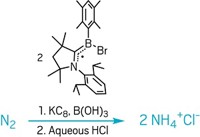Advertisement
Grab your lab coat. Let's get started
Welcome!
Welcome!
Create an account below to get 6 C&EN articles per month, receive newsletters and more - all free.
It seems this is your first time logging in online. Please enter the following information to continue.
As an ACS member you automatically get access to this site. All we need is few more details to create your reading experience.
Not you? Sign in with a different account.
Not you? Sign in with a different account.
ERROR 1
ERROR 1
ERROR 2
ERROR 2
ERROR 2
ERROR 2
ERROR 2
Password and Confirm password must match.
If you have an ACS member number, please enter it here so we can link this account to your membership. (optional)
ERROR 2
ACS values your privacy. By submitting your information, you are gaining access to C&EN and subscribing to our weekly newsletter. We use the information you provide to make your reading experience better, and we will never sell your data to third party members.
Synthesis
New catalyst transforms carbon dioxide into commodity chemicals
A magnesium hydride complex pairs with a boron Lewis acid to selectively hydrosilylate CO2 and convert it to formaldehyde
by Stephen K. Ritter
January 1, 2018
| A version of this story appeared in
Volume 96, Issue 1
A Columbia University research team has prepared a magnesium catalyst that can efficiently convert carbon dioxide to precursors for commodity chemicals such as formaldehyde. Carbon dioxide is usually thought of as an essential molecule for photosynthesis and as a greenhouse gas that helps control Earth’s climate. But because CO2 is abundant and cheap, it also offers much potential as a renewable carbon source for synthesizing chemicals and fuels. The catch is that the gas is not very reactive until it overreacts, so chemists need to come up with catalysts that selectively functionalize CO2 to produce targeted products. One approach is hydrosilylation, but control of the product distribution by high-priced precious-metal catalysts at the hot temperatures they require is challenging and may result in complete reduction of CO2 to methane. The new catalysts prepared by Columbia’s Michael Rauch and Gerard Parkin instead use less costly zinc or magnesium and work selectively at room temperature. In particular, the researchers found that a magnesium benzimidazole hydride treated with the Lewis acid B(C6F5)3 produces a reactive cation-anion pair that coordinates CO2 and transfers the hydride to carbon, efficiently creating a formate intermediate (J. Am. Chem. Soc. 2017, DOI: 10.1021/jacs.7b10776). The formate group can be removed from the catalyst by reaction with different hydrosilanes in the presence of B(C6F5)3 to make various products. For example, triphenylsilane (Ph3SiH) generates a bis(silyl)acetal that is a protected form of formaldehyde, whereas phenylsilane (PhSiH3) generates methane.





Join the conversation
Contact the reporter
Submit a Letter to the Editor for publication
Engage with us on Twitter